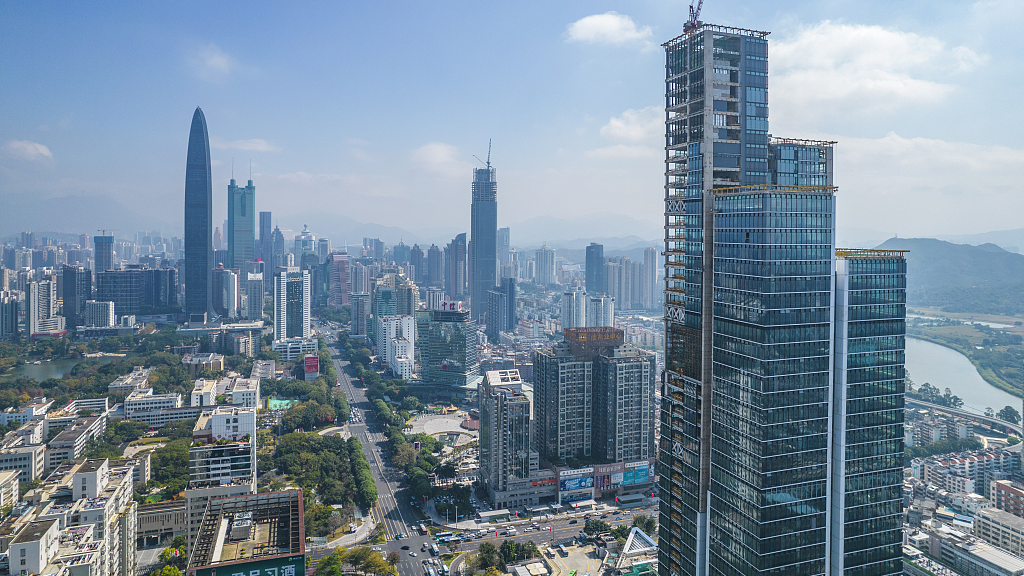
A view of Shenzhen in south China's Guangdong Province, February 2, 2023. /CFP
A view of Shenzhen in south China's Guangdong Province, February 2, 2023. /CFP
Editor's note: Xin Ge is an associate professor at the School of Public Economics and Administration, Shanghai University of Finance and Economics. The article reflects the author's opinions and not necessarily the views of CGTN.
In Tuesday's speech to newly elected Communist Party of China (CPC) Central Committee members and alternate members, as well as principal officials at the provincial and ministerial levels, Chinese President Xi Jinping said China's development shows there are alternative methods to modernize for developing countries, breaking the myth that "modernization equals Westernization."
President Xi, the general secretary of the CPC Central Committee and chairman of the Central Military Commission, addressed China's senior officials at the opening ceremony of the study session at the Party School of the CPC Central Committee (National Academy of Governance). Xi expounded on the Chinese path to modernization, while the modernization process of a country should be "suited to its realities" and "characterized by features unique to its context."
China's modernization path dates back to the founding of the People's Republic of China (PRC). At the Second Plenary Session of the Seventh Central Committee of the CPC held in March 1949, Comrade Mao Zedong emphasized building an industrial country, as well as a socialist country.
From the founding of the PRC in 1949 to the implementation of reform and opening-up policy in 1978, the Party carried out the "Four Modernizations." At the First Session of the First National People's Congress convened in 1954, Chairman Mao proposed a grand vision of transforming the country from "an economically and culturally backward country" into "an industrialized country with a high degree of modern culture." At the meeting, Premier Zhou Enlai endorsed modernization in four aspects: industry, agriculture, transportation and national defense, serving as the initial statement of the goal of Four Modernizations.
Amid the development of socialist construction, the CPC adjusted its strategic goal of national modernization in 1964 – to "build China into a strong socialist country with modern agriculture, industry, national defense and science and technology." In the long period since then, "Four Modernizations" has been the common goal pursued by both the Party and the people with unremitting efforts.
After convening the Third Plenary Session of the 11th CPC Central Committee in 1978, the Party charted a new path to modernization – socialist modernization with Chinese characteristics. Then leader Deng Xiaoping proposed to build a "Xiaokang" society, or a moderately prosperous society.
At the turn of the 21st century, people's livelihood had greatly improved. But the central leadership assessed that the country remained at a relatively low level of Xiaokang. Therefore, then President Jiang Zemin advanced "building Xiaokang in all aspects" at the 16th CPC National Congress, which was reaffirmed by President Hu Jintao at the 18th CPC National Congress in 2012.

A commercial street in Wuhan, central China's Hubei Province, July 2, 2022. /Xinhua
A commercial street in Wuhan, central China's Hubei Province, July 2, 2022. /Xinhua
Since the 18th CPC National Congress, the Party has made significant progress in theory and practice of developing the path to modernization. In November 2013, the Third Plenary Session of the 18th CPC Central Committee identified modernizing China's system and capacity for governance as the general objective for deepening reform, which has become the fifth pillar adding to the Four Modernizations, enriching the meaning of the socialist modernization with Chinese characteristics in the new era.
Now there is clear direction with a two-step strategic plan. The first step is to realize socialist modernization from 2020 through 2035, followed by building a great modern socialist country that is prosperous, strong, democratic, culturally advanced, harmonious and beautiful from 2035 through the middle of this century. Chinese modernization involves the largest population, seeks common prosperity for all, coordinated material and cultural advancement, harmony between humanity and nature, and most importantly it is peaceful development.
This remarkable development of theory and practice in the Chinese path to modernization lies with maintaining firm leadership of the CPC, which is pivotal to the fundamental direction, realization and success of Chinese modernization. As Xi said, the historical task of exploring the Chinese path to modernization fell on the shoulders of CPC members.
Modernization is not a preserve only of the West, nor is there a fixed model. Each country could independently explore a unique path to modernization in line with its national context. Among the 193 member states of the UN, less than a quarter are developed countries, suggesting that modernization remains a major issue for the developing world. China has opened up a modernization path that not only maintains Chinese features, but has global significance, creating a new form of human civilization. With its rich experience, the Chinese modernization path can provide insightful references for other developing countries to seek their own paths to modernization.
(If you want to contribute and have specific expertise, please contact us at opinions@cgtn.com. Follow @thouse_opinions on Twitter to discover the latest commentaries in the CGTN Opinion Section.)